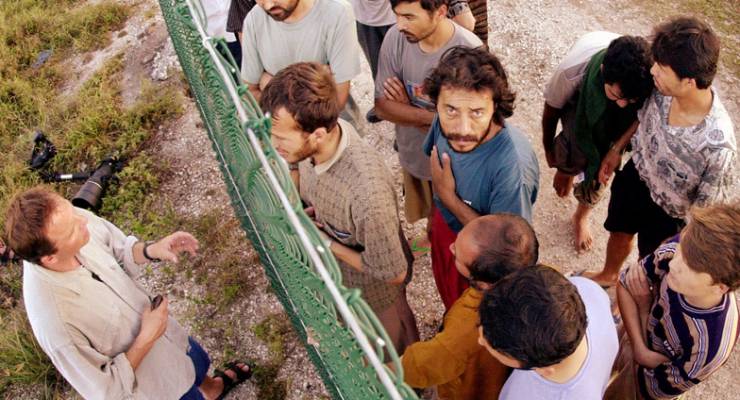
The deal PM Malcolm Turnbull made with then-US president Barack Obama for some of the refugees on Nauru and Manus Island to be resettled in the United States appears dead on arrival, with Donald Trump calling it a “dumb deal”. But what was the deal anyway? And can it be saved?
When was the refugee deal made?
After years of uncertainty surrounding the fate of offshore refugees, in November last year Prime Minister Malcolm Turnbull and Immigration Minister Peter Dutton announced a “one-off deal” to resettle asylum seekers currently on Nauru and Manus Island in the United States. The statement came shortly after Turnbull announced he would introduce legislation to amend the Migration Act and “prevent irregular maritime arrivals taken to a regional processing country, from making a valid application for an Australian visa”. The Prime Minister did not set out a timeline on the process and instead said: “It will take time. It will not be rushed.”
Who made it?
The deal was what Dutton called a “team effort” between the Australian and American governments. The previous Obama administration agreed to the arrangement as it came towards its final days in government. Labor wasn’t briefed but declared its support for the deal. Shortly after the deal announcement, Bill Shorten declared: “Labor would be hypocritical if we didn’t welcome this because this is the very thing we wanted with the Malaysia solution some years ago.” Turnbull dismissed concerns the deal would be disrupted by a new US administration, telling a journalist: “We deal with one administration at the time. There is only one President of the United States at a time. These arrangements have had a long run-up and the agreement was reached some time ago.”
Who are the refugees that would be affected?
The deal would only apply to refugees settled in Australia’s regional processing centres before the announcement was made. As many as 1250 of the 2500 asylum seekers on Nauru and Manus island would be eligible for resettlement in the United States, with a particular priority for women, children and families.
The United States also has an escalating refugee issue with thousands of people trying to flee into the country from Central America. In Central America’s biggest refugee crisis since civil war in the 1980s, thousands of refugees from El Salvador, Guatemala and Honduras are escaping deadly gang violence. Honduras in particular has the highest homicide rate in the world, with 90.4 murders per 100,000 people according to 2013 statistics by the UN Office of Drugs and Crime. Poverty, crime and little protection for authorities has given few options, especially for vulnerable women and children. After agreeing to enter into a protection transfer arrangement with the UNHCR, Costa Rica is hosting and screening refugees before they can be processed for placement in the US.
What is in it for Australia and the US?
Australia could see this as a solution to the hundreds of refugees stranded in its infamous detention centres. The need to relocate the refugees in limbo is also gaining urgency as the PNG government ordered the detention centres to be closed last year. The government doesn’t seem set on allowing the refugees into Australia, as Turnbull also vowed “… irregular maritime arrivals who have been sent to a regional processing country … will never be settled permanently in Australia”. The deal would also put less strain on the Central American refugees being processed for settlement in the USA.
Why would Donald Trump call it a ‘dumb deal’?
Most refugees fleeing Central America are Christian, whereas a large number of refugees abandoned on Nauru and Manus are Muslim. A number of the refugees in Australian offshore detention also come from seven nations listed in Trump’s executive order ban. It wouldn’t make much sense for Trump to trade Christian refugees with Muslim ones following his “extreme vetting” measures. In his phone call with Malcolm Turnbull, Trump accused the PM of trying to send the “next Boston bombers” into the US, according to reports by The Washington Post.
Integration might not be so easy for refugees in Costa Rica considering Australia has a very small Latin American community compared to the US. It might not make much sense to send these refugees thousands of miles from America where they are more likely to have family and stronger community links.








What are the odds that the ‘extreme vetting’ weeds out the majority of our Nauru &
Manus refugees from entering the USA.
Even after reading this, what in the world is the point of swapping people between two countries? We’re playing with people’s lives purely so a couple of politicians can safe face? Are we really that demented?
Remember about two years ago when NZ offered to take the refugees on Nauru and we refused their offer because NZ was too nice a country and therefore could be seen as an incentive for others fleeing their countries? Is the argument not applicable to the US?
Future historians will write about this period in Australia and they will not be kind. Rightfully so. We are a bunch of pricks.
I think that the vicious ‘reasoning’ was even more malevolent than that NZ was too nice but that they would not suffer insufficiently for their effrontery , the lese majeste.
It is the same attitude towards welfare recipients, insufficient suffering.
Wasn’t there a quid pro quo whereby we accepted a significant number of refugees from Costa Rica, or similar? It’s hinted at in the article but nothing more.
I too fear that Trump will declare that ‘our refugees’ don’t pass muster, so we will be back to square one
I hope Duttbull have a Plan B ready to go, but I suspect not.
There’s definitely a Plan B ie: more bastardry.